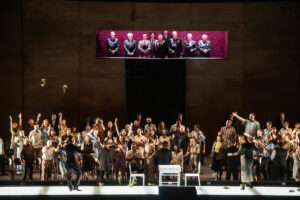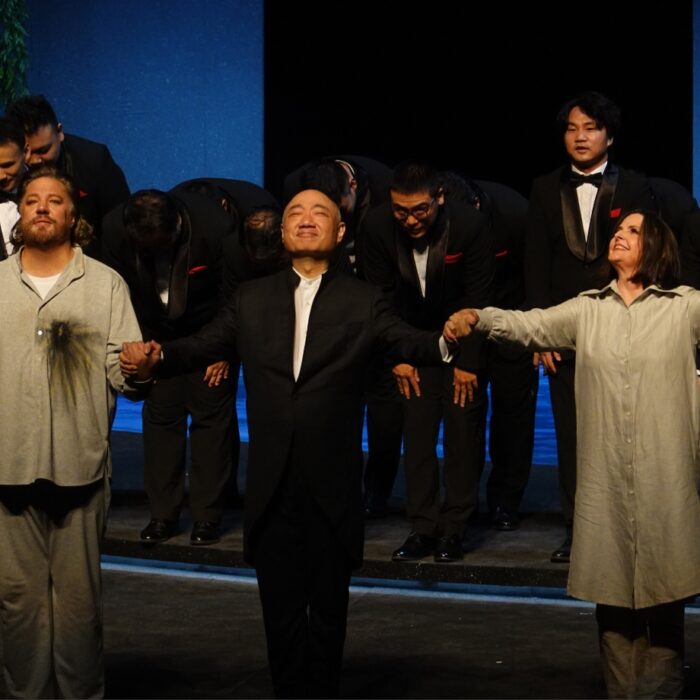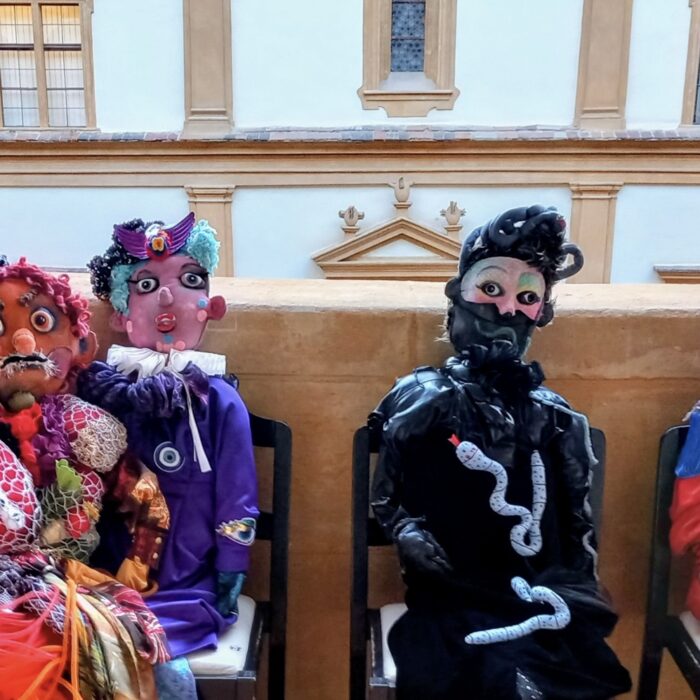
Deutsche Oper Berlin 2024-25 Review: Turandot
Saioa Hernández Gives a Spectacular Turn in Dark Interpretation of Puccini’s Exotic Fairy Tale
By Francisco Salazar(Credit: Bettina Soss)
On Feb. 14, 2025, the Deutsche Oper Berlin closed its revival of “Turandot.”
The company was reviving its 2008 production by Lorenzo Fioroni, which is set in a fairy-tale realm of an indeterminable period. However, it is set in the context of a modern-day dictatorship with the riddle and execution scenes given a ritualistic, quasi-religious role. The audience watches on as executions are played out, with intermittent displays of resistance quickly smoked out by violence. The “stage” sits in downstage. The Emperor and his entourage even get their own private box high above the other spectators and we the audience are made to see ourselves reflected by the corresponding audience. We get glimpses of the behind-the-scenes of the events with Turandot’s “In questa reggia,” one such moments, the Princess hounded by cameras and security guards on one end of the stage, Calaf prepared on the other. The two then sit face to face at a center table where they face off. What’s fascinating here is how it plays with Turandot’s psychology. She is a mere puppet of the regime, her future at stake as a piece of entertainment for the public. The only time when she gets to be a spectator with the Emperor is during the executions. Ping, Pong, and Pang are presented as entertainers, though their main function seems to be as the stage managers for the overall “riddle production.”
The grand spectacle gets pushed to the background in Act three as the stage is destroyed and what we see is the backstage area of the theater. The violence escalates in this scene with a dead Liu hanging throughout the final duet and the final image audiences are given is Turandot and Calaf killing their fathers, liberating themselves from the patriarchy that has presumably forced them into toxic dynamics throughout their lives. The final action features Turandot, knife in hand, encroaching on Ping, Pong, and Pang.
This opens up some interesting ideas. First off, it explores Turandot’s violence and illuminates it. The opera has always been troubled by the titular character’s sudden psychological shift. Yes, technically this story is a fairy tale, but it’s also an drama with fully fledged characters with psychological development. So sitting back and presenting them as archetypal figures only works to a certain extent. Moreover, this particular opera has both complex but also complicated layers and simply presenting it as is, overlooks these issues, especially as pertains to Turandot’s transition from desiring bloodlust to suddenly being smitten with love because she got kissed. Puccini himself couldn’t finish the opera because he wasn’t fully convinced by his heroine’s turn at the end.
Fioroni has a strong proposition and frames the titular character as a woman whose humanity and integrity have been repeatedly compromised and abused by a patriarchal regime that exposes her to potential abuse. “In questa reggia” is thus not only the abuse of a princess from long ago, but her very story, and the story of all women in a patriarchal society continuing to be perpetuated in the present time.
Calaf offering her a way out as a man who will not take her unwillingly, thus gives the opera a unique twist and perspective and even offers a compelling argument for why she eventually accepts him. It isn’t altogether convincing (I don’t think anyone can truly make it make sense when Calaf still forces himself on her for the monumental kiss that changes it all, and the staging in that final duet is stiff and imprecise here, but it’s as close as anyone has come to unlocking it), but by having Turandot murder her father and his flunkies at the end, it shows that her trauma isn’t magically overcome, but instead shifted toward a different target. It also leaves us with the question of what kind of leaders Turandot and Calaf will be and if the violence that they have been subjected to will continue in their regime. It’s an interesting conclusion for an opera that is always consumed in mysticism and fairy tale but sometimes loses the reality of who Turandot’s desire for vengeance.
But then comes the problem of Calaf. He’s presented as an everyman who overcomes his “humble” status to rise above and must sacrifice his father for power. But it never feels earned and the portrayal of the moment has no sign of internal conflict. There’s no suggestion of abuse here in this relationship and it only seems necessary to satisfy Turandot’s redirected bloodlust. If Turandot’s assassination of her father is bold, understandable, and earned, Calaf’s seems more intent on adding shock value and didacticism than having true narrative value.
Nonetheless, this is a compelling vision of one of Puccini’s most dramatically perplexing works.
A Diva Reigns Supreme
Without a doubt, the star of the evening was Saioa Hernández in the title role. The Spanish soprano has undoubtedly become a staple in the dramatic repertoire and it is obvious why once you see her live. You simply can’t take your eyes off of her. She dominated “In questa reggia” and the riddle scene with great force and even at the end of Act two, when Turandot loses control of her circumstances, she took out a gun in self-defense, desperately rushing about the stage. In Act three, she sat upstage on a throne, eyeing everyone’s movements. She didn’t have to say or do anything and you still couldn’t help but thrill in trying to read her mind, figure out what she was scheming. Few artists today have that kind of stage presence and magnetism.
Vocally, Hernández was similarly compelling. She opened “In Questa Reggia” with an imposing forte that rose to resonating high notes, especially on “E quel grido, traverso stirpe e stirpe.” She scaled down the sound during “Principessa Lou-Ling, ava dolce e serena,” delivering long legato phrases and a resonant middle voice that was slowly cut with more staccato phrases as the the aria grew more agitated. The soprano eventually crescendoed on the climatic “quel grido e quella more!” The highest notes rang with clarity and authority into the auditorium. From there the voice continued to move with flexibility from her incredible chest voice to the vibrant top notes.
In the riddle scene, Hernández had complete dominance over the text. During the first riddle, “Nella cupa notte vola un fantasma iridescente,” she opened with the same imposing tone emphasizing her power over Calaf. The phrases, slowly diminuendoed, especially as she went into her chest voice and emphasized Turandot’s sardonic nature. In the second riddle, Hernández’s anger started to seep through on a very accented “Sì, la speranza che delude sempre!” During the second riddle “Guizza al pari di fiamma, e non è fiamma,” the soprano delivered vocal anger and desperation, pushing the tempo forward,, the phrases growing more staccato. During the final riddle, “Percuotete quei vili!,” the voice obtained a metallic quality, emphasizing her loss of power. However, Hernández never lost her control in the scene and her “Su, straniero, il gelo che dà foco,” was delivered with a sense of pride and victory.
The subsequent concertato saw Hernández upstage, firing away high notes of desperation, her sound carrying potently over the entire ensemble. It was epic as Hernández honed into Turandot’s despair, especially in “Figlio del Cielo! Padre augusto!”
In Act three, during the final duet, Hernández imbued similar vocal power before finally going back to a more intimate and fragile sound. Her “Che mai osi, straniero! Cosa umana non soon!” finally saw Hernández’s soprano shift toward piano colors and textures; she floated several notes sublimely and the timbre acquired sweetness. Her “Che nessun mi veda, la mia gloria è finita!” was ethereal and resonated gorgeously into the auditorium. The “Ah! Del primo pianto!” was also rhythmically precise and had a sense of despair and anguish. However, her voice regained power as the duet developed, and when she sang the phrase “So il tuo nome! So il tuo nome!” Hernández retained the same imposing sound from Act two with the voice crescendoing with each high note. It was astonishing to hear how clear the Spanish sopranos high notes were.
She’s an incredible artist and I felt grateful, as someone who resides in the United States and never gets the chance to see her, to get an opportunity to witness her greatness.
Mixed Results
In the role of Calaf, Jorge Puerta was solid but ultimately disappointing. In his opening phrases, Puerta came off a bit tentative but quickly recovered during “Non piangere Liù.” During this aria, he showed a pure legato line and a variety of dynamics that slowly grew in volume and power. But as he reached the higher reaches of his voice, the sound came off disconnected from the sweeter middle range. There was a nasal quality to those high notes that would be present throughout his performance. Nonetheless, during the concertato “Ah! per l’ultima volta” he also led the massive chorus with great power and his three “Turandots” crescendoed one after the other.
At the end of “In questa Reggia,” Puerta was underpowered next to Hernández’s immense sound creating an unbalance in the climactic moment. Then in the riddle scene, while completely engaged in the scene and acting with complete commitment, his voice obtained an airy texture, especially in the upper range. The sound was colorless and it felt as if he were running out of air. That took away from the heroic nature of Calaf. He did improve at the end, during the passage “Il mio nome non sai. Dimmi il mio nome,” where he softened the voice providing it with some delicacy. He also floated a gorgeous piano on “morirò.”
In Act three, his “Nessun Dorma” was sung with a lyric flexibility that allowed him to shape the aria with many colors and a gorgeous line. However, it was completely covered by the orchestra and the climatic B flat did not resonate. In the final duet, he was also overpowered by the orchestra and Hernández, but did showcase some heroic sound in the “Il mio mistero? Non ne ho più!” and “Io sono Calaf, figlio di Timur!” His highs in the “La mia gloria è il tuo amplesso! and “Hai vinto tu!” were also quite powerful and he was able to measure up to Hernández’s immense sound.
In the role of Liù, Maria Motolygina gave a solid if somewhat uneven performance. Her first aria “Signore, ascolta!” saw a delicacy in her middle range as she easily brought out a piannissimo sound. But when she tried to float the final note with a similarly soft sound, she struggled to maintain it and the voice obtained a metallic and wobbly sound. the intonation unstable. In the third act, Motolygina sang with passion throughout her “Tanto amore segreto e inconfessato, grande così.” The lines were connected as she sang gently and slowly built up to a climactic forte. However, she encountered some pitch issues and sometimes got off from the orchestra throughout the latter end of the aria. But, as she finished the section, she sang “ah, come offerta suprema del mio amore!” with an affecting timbre. Later in her “Tu che di gel sei cinta,” the soprano sang with a deep middle range even if sometimes the legato notes didn’t always connect and her higher register didn’t have a clear ring. That said she delivered pure passion in this aria and her “Per non vederlo più!” was cathartic with the soprano delivering an immensely warm sound.
Bass Gerard Farreras had a solid evening singing the role of Timur. He had a booming quality in the first act, especially in the final chorus, and in Act three following Liù’s death, he delivered desperation and grief, the voice darker and rounder. However, he did sound rugged at some points and the lower notes obtained a grainy quality that didn’t ring clear.
In the roles of Ping, Pong, and Pang, Michael Bachtadze, Kangyoon Shine Lee, and Thomas Cilluffo ate up the stage, dressed in drag and playfully mocking other characters in the opera. Their voices also blended wonderfully during their Act two scene. It was excellent ensemble work in every way.
In the pit, Jordan De Souza had some balance issues as the orchestra sometimes got a bit too bombastic, especially in the final chords of Act two. Some of the dissonance was way too pronounced during that Act two transition. As noted, in Act three during “Nessun Dorma,” De Souza covered Puerta, taking away the heroic nature of the aria. The chorus was also sloppy in the opening scene with the orchestra and chorus out of synch in some instances. That said the Riddle scene was tense and suspenseful with the rumbling tremolos of the percussion, creating palpable suspense. He also followed Hernández incredibly well throughout “In Questa Reggia.”
Overall, this was a solid evening and a great way to rediscover “Turandot” with one of the greatest living sopranos headlining the cast.


